|
An exclusive interview on
“THE EYE OF ISTANBUL: THE LIFE AND PHOTOGRAPHS OF ARA GÜLER” | Part 1 of 2
WHAT WILL HAPPEN TO ARA GÜLER’s
UNMATCHED PHOTOGRAPHY ARCHIVES?
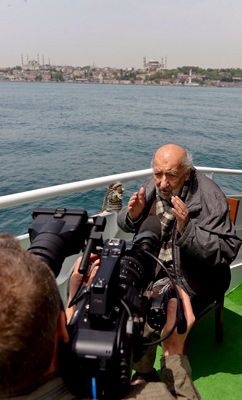 |
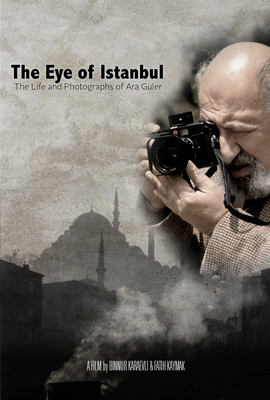 |
Ara Güler during the shooting of the documentary |
The poster of The Eye of Istanbul |
Interview with Binnur KARAEVLI, Director of "The Eye of Istanbul"
Conducted by Bircan Ünver for The Light Millennium
[March 6, 2016, Lightmillennium.Org] THE EYE OF ISTANBUL screens at the DCIFF on March 13, 2016 at 11:30 am at the US Navy Memorial, 701 Pennsylvania Ave NW, Washington, DC 20004. The screening is the world premiere.
Binnur Karaevli and Fatih Kaymak’s “The Eye of Istanbul” tells the story of Ara Güler, the legendary Armenian-Turkish photographer, through a culmination his retrospective exhibition in Istanbul. As Ara selects his photographs, the stories behind his most iconic images spring to life. At 88 years old (1928), Ara is a complex and unforgettable character; he is still philosophical, witty, and irreverent.. Although he is mostly recognized for his black and white photographs of Istanbul, he has enjoyed an international career, which has spanned over sixty years and has generated more than one million photographs. Ara’s artistic process, his resourcefulness and fearlessness are revealed through a non-linear narrative in the film. Ara is revered in his homeland, however, the question remains as to what will happen to his archives, which are deemed to be a national heritage of Turkey and a global treasure.
The film was recently completed in November 2015 and is currently being submitted to film festivals and distributed internationaly. The film is having its world premiere at the DC Independent Film Festival. Award-winning director, Binnur Karaevli has garnered praise and awards for numerous films, such as “Voices Unveiled”, “Searching for Paradise”, “Dance of the Whirling Dervish” and “Evelyn of the Desert”. The Eye of Istanbul is directed by Binnur Karaevli and Fatih Kaymak, produced by Umran Safter and written by Binnur Karaevli and Ahsen Diner.
Bircan Ünver (BÜ): As first, congratulations. It is indeed, very critical and timely profiling of Ara Güler, and to bring to public attention of his life and works both the peoples of Turkey and global community as the most prominent internationally renowned photojournalist, who was born and raised in Istanbul as a Turkish-Armenian citizen.
Let’s begin with a very generic question: How did this documentary project evolve and come into realization?
Binnur Karaevli (BK): I was thinking about making a new documentary about the people of Istanbul because I wanted to create a trilogy on Istanbul. I had already done “Searching for Paradise”, --an autobiographical documentary about living between the East and the West-- and “Voices Unveiled” about the women of Istanbul. I wanted my last film in the trilogy to be about the Istanbul that has been lost, the city that no longer exists. I have been a fan of Ara Guler’s photography for many years. His Black and White photographs from Istanbul are full of longing, mystery and feelings. So I thought that making a documentary about Ara Guler and his photographs would be a great journey.
He [Ara] chose to spend most of his time photographing
the poor and disadvantaged people of Istanbul.
BÜ: What was your initial perception both of Ara Güler and his photographs prior to the documentary, and how has your perception changed since you’ve completed it?
BK: When I was studying at Carnegie-Mellon University and later on at USC, I would visit Istanbul during vacations and I would always buy Ara Guler postcards to send to my friends back in the US. I always had a visceral reaction to his photographs. I love the faces of the workers the people and the children in his photographs. They are so alive; they feel like they will jump out of the photograph. In all honesty, I only knew that Ara is a living legend in Turkey but I didn’t know much about his life before I started working on the documentary. When I met Ara and found out that he grew up in a very wealthy and cosmopolitan household and that his family wanted him to take over the family business, I became curious about Ara’s personality. He could have had a very comfortable life as the son of a wealthy pharmacist and the heir of a fortune. But he chose a more difficult profession. He chose to be a photojournalist and travel the world and live under difficult conditions. He also chose to spend most of his time photographing the poor and disadvantaged people of Istanbul. What would possess this man to leave a comfortable life behind, defy the wishes of his family and go out to the world to photograph the suffering of the poorest of the poor? I really wanted to find the answers to that journey in the film.
After getting to know Ara and studying his career, which spanned over 60 years, I am in awe of his passion, persistence and artistic instincts. I learnt a lot about photography and the history of photojournalism during the course of working on this film.
BÜ: One of the most compelling sections in the documentary is “The Scream of Aphrodisias”.
It proves to us that a photojournalist can also be a discoverer. Could you please elaborate on how valuable archeological sites have been sacrificed for energy power plants, or covered up with sand and left to be robbed? Also, in this context, through Güler’s photographs on the Aphrodisias, what benefits have come to Turkey and the world?
A seen from Aphrodisias
|
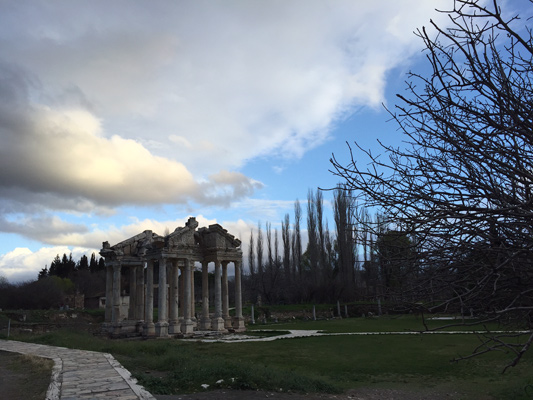 |
Lo and behold, Aphrodisias has been discovered!
BK: The story in the film tells how Ara Güler discovered a major archeological site in Turkey. In 1958 Ara is sent on assignment to Southwestern Turkey to photograph the construction of a new dam. He gets lost and ends up spending the night at a small village. There he sees that there are lots of Roman columns. The men in the coffeehouse are playing card games on tables built from Roman ruins. Ara is intrigued and he takes many photographs of the ruins and then sends these photographs to the Architectural Review magazine. And lo and behold, Aphrodisias is discovered! Now it is one of the largest open-air museums in the world.
There are several interesting aspects to this story that reflect Ara Güler’s personality. First of all, Ara Güler is a very educated man. He recognizes Roman columns when he sees them. He realizes that he is in an ancient city. Ara is a curious individual. It is his curiosity and passion that has propelled him to take photographs for over 60 years. He is curious about the ruins so he wakes up early the next day and surveys the area and takes photographs. Ara Guler is cosmopolitan; he speaks fluent French, English and Turkish. He knows where to send the photographs. He knows about the magazine Architectural Review and he can write to them in English. As a filmmaker, I look for stories that are interesting and can tell us something about the character. I love the story of the discovery of Aphrodisias because it not only captures Ara’s passion, curiosity, and relentless pursuit of new experiences but also his knowledge, depth and resourcefulness.
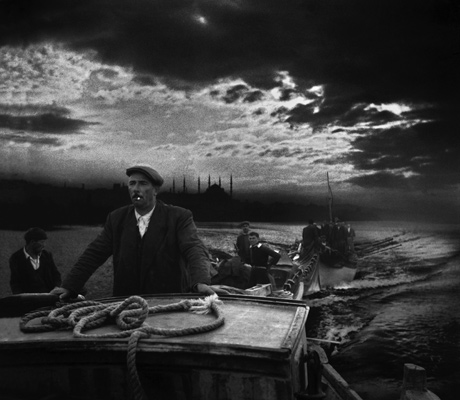
BÜ: "Memleketin Yüzleri/Faces of my Country” is the title one of the piled up boxes in his office that I noticed in the film, which also has a resemblance to Nazim Hikmet’s “Insan Manzaralari/Human Landscapes”. Yet, the documentary hasn’t mentioned any aspects of his interest-- photojournalist stories with the prominent Turkish cultural and literary icons, such as Nazim Hikmet and Yasar Kemal, as prominent worldwide accomplished photojournalists. I wonder why some of the Turkish cultural icons have been left out or not reflected in the documentary?
BK: Ara Güler’s career spans over 60 years. He has photographed hundreds of thousands of people. He has attended 4 wars including the Palestinian-Israeli conflict in the 60s as a photojournalist. He has visually recorded every event that happened in Turkey since 1950, he has witnessed military coups, social unrest, etc. I could have easily made a documentary series about his life and work. While I was conceiving the film and then when I was editing it, I had to make tough decisions. My biggest dilemma was whether to make this film for the Turkish audiences or for the international audiences. I chose to make a film that people all around the world can watch and appreciate. If I went into his relationships with Yasar Kemal, Nazim Hikmet, Kemal Tahir and other famous writers and poets in Turkey, I had to give a lot of context and backstory of their relationships. Besides, Ara Güler did not talk about any particular Turkish figure that influenced him and affected his photography. He only talked about how attending theatre school and being a projectionist at a movie theatre set the building blocks of his art. Therefore, I decided to concentrate on more universal stories from his life such as his discovery of Aphrodisias.
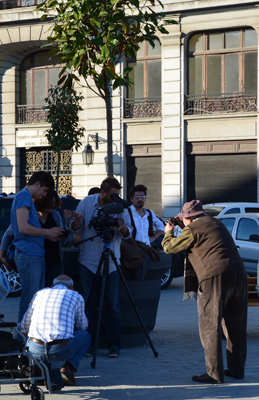 |
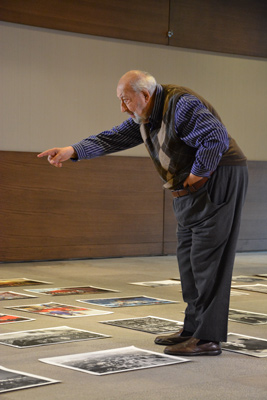 |
| Eye of Istanbul, Ara Güler, Photo-sinema verite |
Ara Güler is selecting his photos for his Retrospective in 2015. |
BÜ: The documentary develops and unfold around his Retrospective Photography Exhibition in Arte Gallery in 2015. I think only 65 photographs were exhibited in it, and mostly selections made from 1955 to the early 1970s. With that said, do you think 65 photographs was sufficient to represent his career, out of over one million photos.
BK: Of course, the exhibition was not a full reflection of Ara Güler’s 60-year-old career. When I conceived the film, I had one important condition and that was a Retrospective Exhibition. When we started talking to Ara Güler about the film, we also talked to him about the Creation of a Retrospective Exhibition. My idea was to shoot much more of the preparation of the exhibition and have some say so in the amount of photographs that were selected for the exhibition. I would have liked to have different sections of the exhibition such as Turkish Artists and Leaders, Istanbul from the 50s till the 80s, International Artists and Leaders, the World and Anatolia. However, after we started the production, several weeks into our shoot, Ara’s people informed us that there was an exhibition under way at the Arte Gallery and that we should shoot that exhibition. The Arte Gallery owner was very helpful but I really would have liked to shoot a much larger retrospective which would have made our film richer. However, in the world of documentaries, you don’t have as much control over the course of the events. So we went along with the exhibition at Arte Gallery and it all worked out well.
As far as addressing Ara’s career in the film is concerned, I believe that I have done that. We have shown his most iconic images in the film and covered his periods. So I was not restricted with the exhibition when it came to using his archives.
BÜ: Do you think that documentaries have a role and power for cultural and social change?
If so, what do you expect to be changed through the EYE OF ISTANBUL documentary?
BK: I do believe that films and documentaries can impact social change. They can also impact individuals and those individuals can work for cultural and social change. If I didn’t believe in the power of storytelling as a tool to change our lives for the better, I wouldn’t be doing what I am doing. I hope that Turkish people who watch The Eye of Istanbul would realize the importance of Ara Güler’s archives and take some action about it. His archives are the cultural heritage of Turkey from the 1950s till 2000. They have to be preserved. I also hope that the global audiences who watch the film will get a glimpse of an amazing photojournalist from Istanbul and gain awareness of a world that they have not been exposed to before.
What will happen to Ara Güler’s archives?
BÜ: In the documentary, it is stated several times including by Ara Güler himself that he considers himself as a “visual historian”. Güler’s spanning collection of photos is a cultural, historical and visual treasure and heritage of Turkey. In this general context, I have not seen an interview with the Ministry of Culture and Tourism of Turkey that elucidates what the official standpoint and/or project to protect and make Ara Güler’s 60 years of photo-visual archive globally available, such as through an online Ara Güler Photography museum.
BK: I am not sure what the official standpoint is concerning Ara Güler’s archives. I know that he is revered in Turkey and that various different private foundations and private/public universities have sought out his archives. At some point Ara Güler started a foundation of his own to preserve his archives but then he dissolved the foundation. After the shooting of our documentary was done, it was announced that Dogus was going to buy his archives. Then it was announced that the deal was off. I don’t know what the latest situation with his archives is. I believe that Ara Güler has a lot of people advising him one way or another. As a filmmaker, my goal was to show what a treasure his archives are and to pose an important question: what will happen to his archives? I feel like I have achieved what I set out to do. The question of what will happen to Ara Güler’s archives is out in the open now. But it is ultimately Ara Güler’s decision.
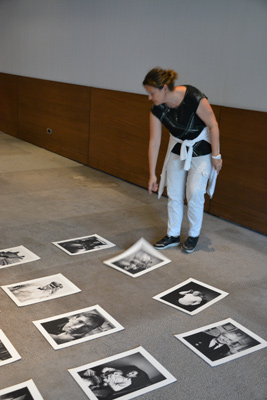 |
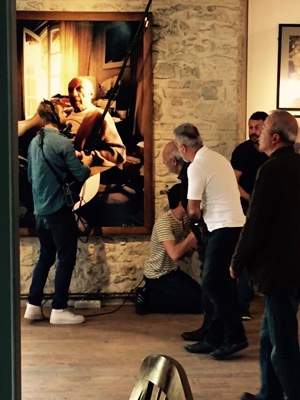 |
| Binnur Karaevli during the photo selection session for the Ara Güler Retrospective Exhibition at Arte in 2015. |
The crew of The Eyes of Istanbul at the Arte Gallery an in front of Ara Güler's Picasso photograph. |
There are more than a million frames that have not been printed yet.
BÜ: In this context, you’ve also conducted interviews with representatives from the Istanbul Modern and Mimar Sinan University Photography Departments. What are these institution’s approaches, to archive his work during his lifetime.
BK: I am not sure how Istanbul Modern and Mimar Sinan University approach Ara Güler’s archives. The people I interviewed from those institutions could only talk about their knowledge of Ara Güler’s photography. They are not in liberty of speaking for their institutions when it comes to important policies such as inquiring archives. I am a filmmaker; I am not a curator or an archivist so I cannot make suggestions about how Ara Güler’s archives should be handled. However, as a person who grew up in Istanbul, I do care about Ara Güler’s archives. I would love to see a museum dedicated to his photographs. I also think that his archives need to be studied and opened to the public. There are more than a million frames that have not been printed yet. That’s why I wanted to call attention to his archives.
BÜ: If there is none interest in this very important task by the officials and aforementioned institutions, then I wonder that if Ara Güler or someone around him has approached to the UNESCO for the very same purpose, or the United Nations Alliance of Civilizations since his photographs are also an excellent form of representations of “alliance of civilizations”?
BK: I have no idea. Ara Güler has many people around him including attorneys, assistants, biographers, friends, scholars and so forth. I am sure that he is getting plenty of advice. I wanted to make a character driven documentary about a very interesting photojournalist. The truthfulness of his photographs affected me deeply. There is great beauty in truth. I wanted to capture the essence of the man and his work. That was my mission. I also wanted to end the film with a question and that question is: what will happen to these beautiful photographs that we have been seeing on the screen for an hour.
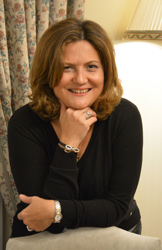 |
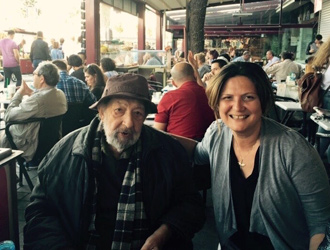 |
| Binnur Karaevli |
Binnur Karaevli, director of The Eye of Istanbul, with the Eye of Istanbul, Ara Güler |
For further information, visit www.eyeofistanbul.com.
For Biography of Ara Güler, please click here
2015 Ara Güler Retrospective Exhibition at Arte Gallery, Istanbul
www.binnurkaraevli.com
Posted on March 6, and updated on March 8, 13, 2016 | Special Thanks To: J.U.C. for proofreading.
|

